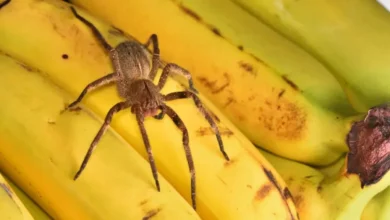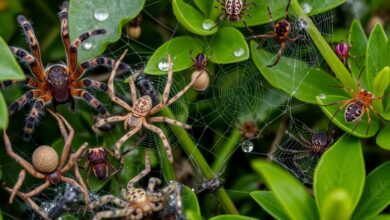Crab Spiders: Nature’s Tiny Ambush Hunters
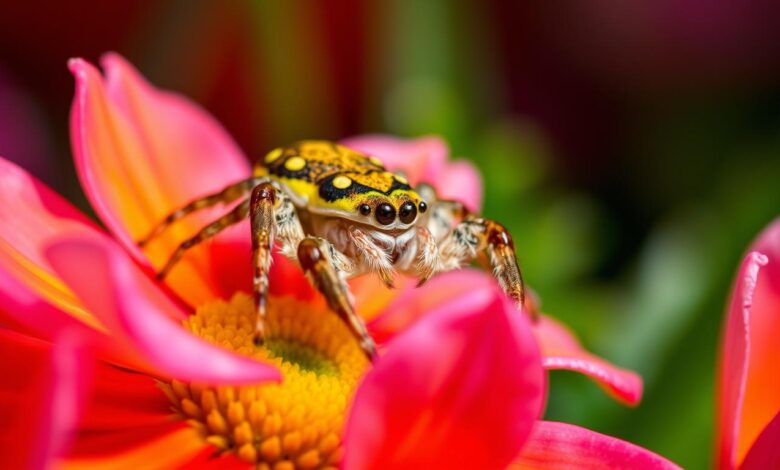
Crab spiders belong to the Thomisidae family. They are tiny but mighty, playing a big role in their ecosystems. These spiders are experts at hiding and catching prey, thanks to their crab-like shape and camouflage skills.
Crab spiders live in many places around the world. You can find them in gardens, forests, grasslands, and wetlands. Their ability to adapt and hunt makes them interesting to scientists and nature lovers. Let’s explore how crab spiders survive and thrive, and why they’re important for nature’s balance.
Introducing the Captivating CRAB SPIDERS
Crab spiders belong to the Thomisidae family, with over 2,000 species. They are known for their crab-like look and behavior. Their bodies are flat, and their legs are long and spindly, allowing them to move sideways.
Crab-like Appearance and Behavior
Unlike web-spinning spiders, crab spiders don’t use webs to catch prey. They use their camouflage skills to hunt. They can blend into flowers or tree bark, making them hard to spot.
Their crab-like movements and stillness help them ambush prey. They strike quickly, catching their victims off guard.
Incredible Camouflage Experts
Crab spiders’ camouflage is amazing. They can change color to match their surroundings. This makes them almost invisible to prey and predators.
They wait patiently for the perfect moment to attack. Their camouflage is a true wonder of nature. It shows the incredible skills of the thomisidae family.
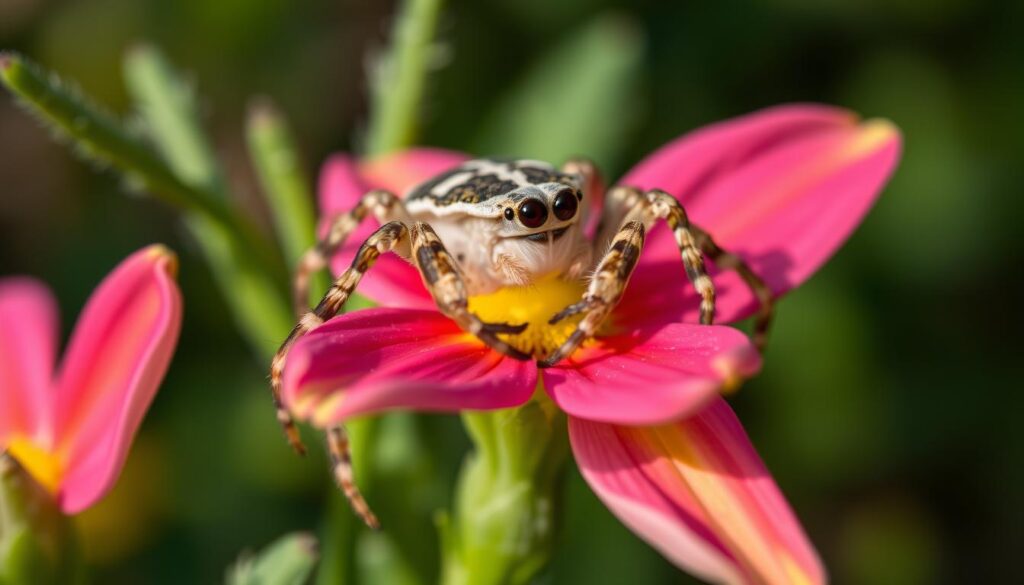
Physical Characteristics of Crab Spiders
Crab spiders are truly captivating creatures. They have a unique physical appearance that sets them apart. These spiders vary in size, from just a few millimeters to over a centimeter. Their vibrant colors and patterns make them stand out, ranging from bright yellow and white to shades of brown and green.
Flattened Body and Spindly Legs
One of the most distinctive features of crab spiders is their flattened body and spindly legs. This unique body shape lets them lie in wait for their prey. They blend seamlessly into their surroundings. The lateral movement of their legs mimics the movement of crabs, making them less noticeable to both predators and prey.
Vibrant Colors and Patterns
The vibrant colors and patterns of crab spiders are not just aesthetically pleasing. They serve a vital purpose. Their camouflage is essential for their hunting strategy. It allows them to blend in with their environment and ambush their unsuspecting prey. Whether they’re perched on a flower or nestled among the leaves, crab spiders are experts at remaining undetected.
| Characteristic | Description |
|---|---|
| Size | Vary from a few millimeters to over a centimeter in length |
| Body Shape | Flattened body and spindly legs, mimicking the appearance of crabs |
| Colors and Patterns | Vibrant hues ranging from bright yellow and white to brown and green, providing excellent camouflage |
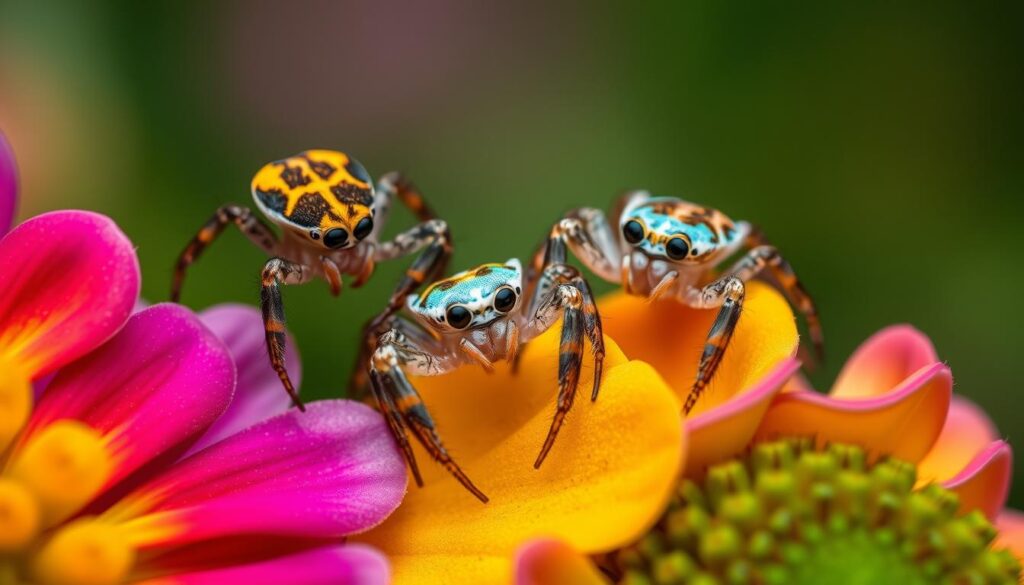
Ambush Predators: Stealth Assassins of the Arachnid World
Crab spiders are experts at ambush, waiting patiently to strike with speed and precision. Unlike many spiders, they don’t use webs to catch prey. Instead, they rely on their stealth and agility to become the spider world’s true assassins.
Crab spiders are very good at hunting, with a success rate of 30% to 70%. They can catch insects that are 1.5 to 3 times their size. Their speed is unmatched, striking in milliseconds when they sense vibrations from prey.
Their success comes from their amazing camouflage. Crab spiders can change color to blend with flowers or foliage, making them almost invisible. This ability to change color is key to their hunting success, allowing them to ambush prey effectively.
These stealth assassins thrive in various habitats, from forests to meadows. Their ambush tactics and quick strikes make them powerful predators. They are known as the “stealth assassins” of the spider kingdom.
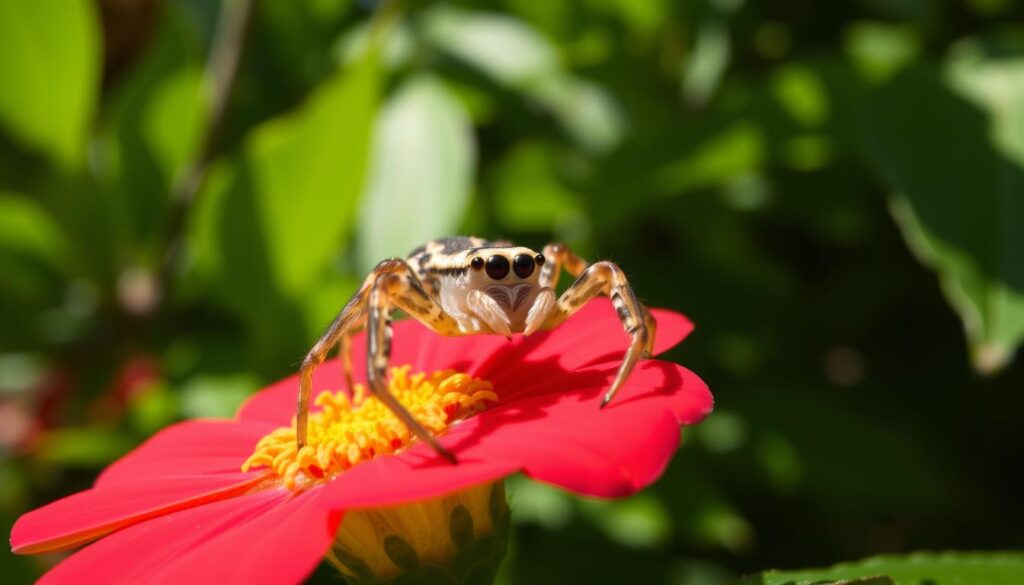
| Prey Captured | Frequency |
|---|---|
| Green bottle flies (Lucilia sericata) | 7 |
| Praying mantis species | 3 |
| Katydid (Tettigoniid) | 1 |
| Leafhopper assassin bug (Zelus renardii) | 1 |
| Spotted cucumber beetle | 1 |
| Jumping spider (Phidippus audax) | 1 |
Diverse Habitats and Global Distribution
Crab spiders are amazing creatures that fascinate people everywhere. They live in many places, from beautiful gardens to thick forests. Their ability to adapt shows how strong and successful they are.
 Fascinating Spider Types: A Web of Wonders
Fascinating Spider Types: A Web of Wonders
Crab spiders are experts at hiding. They often live on bright flowers and green foliage. This helps them sneak up on their food, making them great hunters.
From Gardens to Forests, Their Homes Vary
Crab spiders live in many different places. They love gardens with lots of colors and plants. But they also live in forests, grasslands, and even wetlands.
They can live in so many places because they are very adaptable. Crab spiders have special ways to survive in different ecosystems. They can be found in both bright gardens and dark forests. This means we can see them in many natural places all over the world.
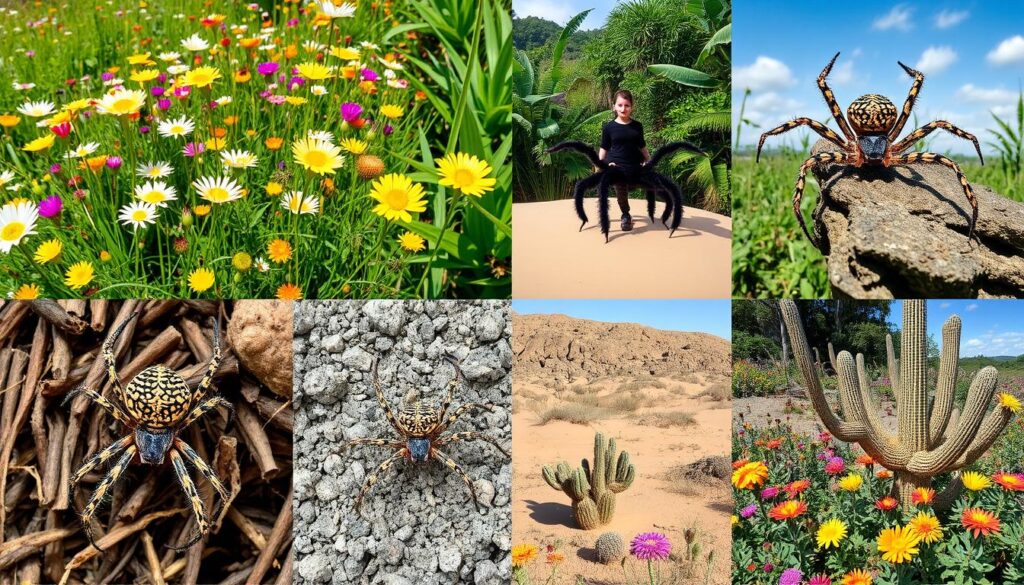
Thomisidae Family: Exploring the Crablike Hunters
The Thomisidae family includes over 2,000 species of crab spiders. These spiders have evolved unique adaptations. They are successful ambush hunters in their ecosystems.
Crab spiders vary in size, from a few millimeters to over a centimeter. They are found worldwide, in places like gardens and forests. Their bodies are flat and legs are long, making them look like crabs.
| Crab Spider Characteristics | Key Facts |
|---|---|
| Appearance | Flattened body, spindly legs, crab-like shape |
| Size | Ranging from a few millimeters to over a centimeter in length |
| Habitat | Gardens, forests, grasslands, wetlands, and other diverse environments |
| Behavior | Ambush predators, some exhibit “flower masking” to attract pollinators |
| Ecological Significance | Control insect populations, contribute to ecosystem health |
| Conservation Concerns | Habitat loss, climate change, and pesticide use affecting populations |
Crab spiders can change color to hide and catch prey. Some even hide on flowers to catch pollinators.
Despite their small size, crab spiders are important in controlling insects. They help keep ecosystems healthy. But, they face threats from habitat loss and pesticides. We need to protect these unique crab-like hunters of the thomisidae family.
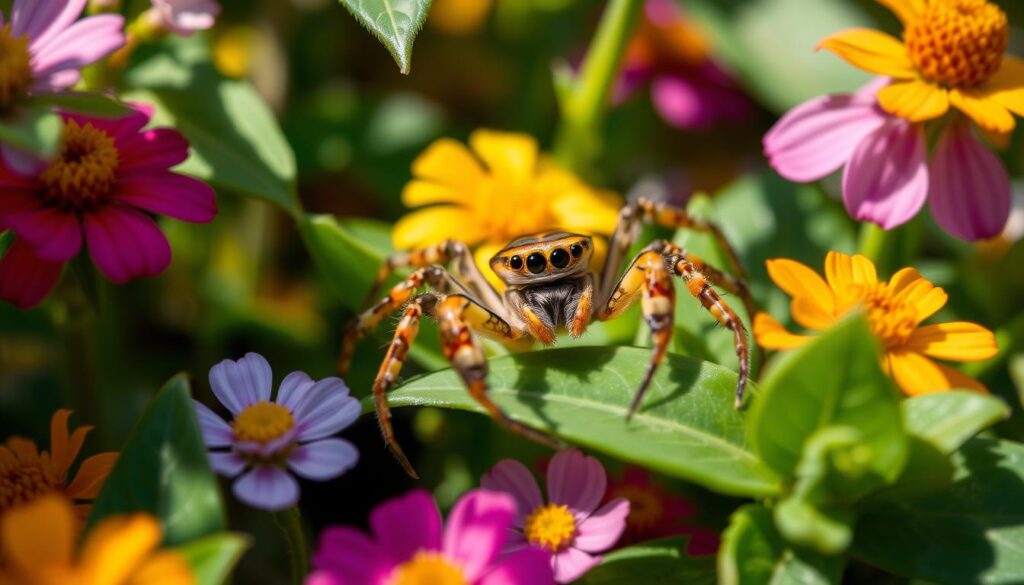
Deceptive Lurkers: Flower Stalkers and Prey Lures
Crab spiders are known as the “deceptive lurkers” of the arachnid world. They have a special ability to hide and lure prey. Some crab spiders hide on flowers to catch their prey.
These flower stalkers blend in with flowers using their bright colors. They hide from their prey. Bees, butterflies, and hummingbirds, attracted to flowers, become their prey.
Floral Masking and Pollinators as Prey
Crab spiders can hide in flowers very well. They look just like the flowers they live on. This makes it hard for their prey to see them.
When a pollinator lands, the crab spider quickly grabs it. This shows how smart crab spiders are. They play a big role in nature’s balance.
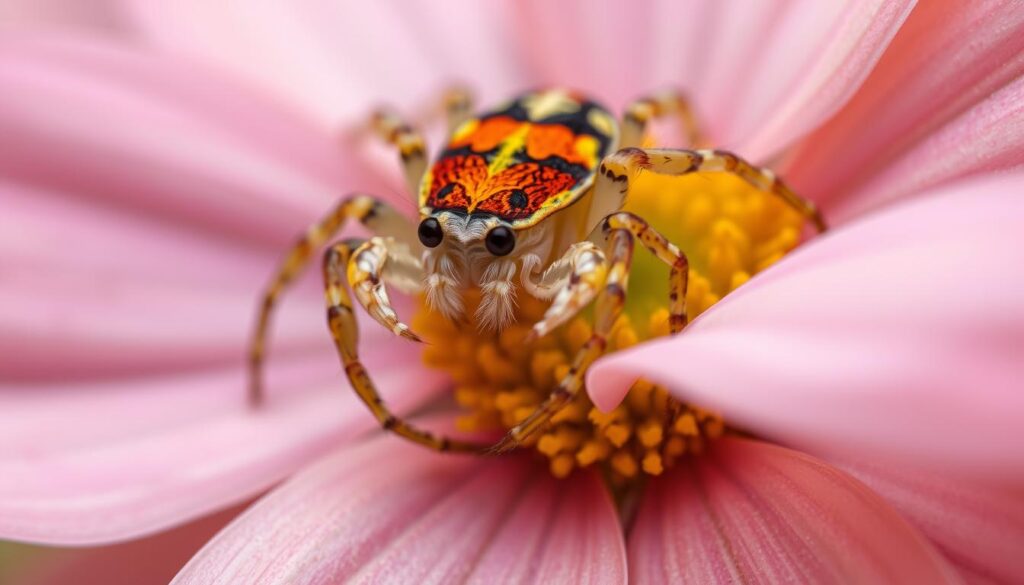
The way crab spiders catch their prey is amazing. It shows how nature is full of clever tricks. Predators and prey are always trying to outsmart each other.
Mating Rituals: Courtship Dances and Cannibalism
Crab spiders, part of the Thomisidae family, have amazing mating behaviors. They have over 2,000 species worldwide. These spiders can be very small or grow up to a centimeter long, showing their diversity.
The male crab spider’s courtship dance is truly impressive. They use their long legs and flat bodies to dance for up to an hour. This dance is to attract the female, who watches carefully and decides if she wants to mate.
But, this dance comes with risks. It can attract predators, making the dance dangerous. Also, some females might eat the male after mating to get more nutrients. This shows the fierce competition and high stakes in crab spider mating.
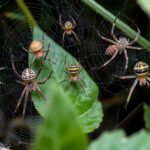 Spiders: Facts and Information You Should Know
Spiders: Facts and Information You Should Know
Despite the dangers, crab spider mating rituals are fascinating. They show how these tiny hunters have adapted to ensure their species survives.

Ecological Significance of Crab Spiders
Crab spiders are key to keeping ecosystems in balance. They are skilled hunters that help control insect numbers. This keeps plant communities healthy.
By eating pollinators like bees and butterflies, crab spiders affect how plants reproduce. This changes the food chains in their habitats.
Controlling Insect Populations
Crab spiders hunt many insects, like flies and mosquitoes. Their clever hunting and camouflage make them great at controlling insect numbers. This helps plants and other organisms thrive.
Influencing Plant Reproduction
- Crab spiders eating pollinators can change how plants are pollinated. This affects how plants reproduce and spread.
- Their presence might keep pollinators away from some flowers. This can lower seed production or change plant types.
- But, crab spiders can also help diverse plant species grow. They eat dominant pollinators, letting other plants compete.
Having many crab spider species in an ecosystem shows it’s healthy. They play a big role in controlling insects and affecting plant reproduction. This makes crab spiders vital to natural habitats.

Crab Spider Hunters: Benefits and Misunderstandings
Crab spiders might look scary, but they’re mostly harmless to people. They’re actually good for gardens. As crab spiders are skilled hunters, they help control insect numbers. This means we don’t need to use harsh chemicals as much.
But, many people have misconceptions and fears about spiders. This fear often leads to crab spiders and other harmless spiders being unfairly treated. It’s key to teach people about these creatures and their ecological benefits.
Harmless Allies in Gardens
Crab spiders have a unique crab-like look and way of moving. They hide in flowers and leaves, waiting to catch their prey. Instead of being a danger, they’re harmless allies in gardens, keeping insect numbers in check.
Dispelling Spider Myths and Fears
By learning about crab spiders, we can dispel common myths and fears. These spiders are not aggressive and don’t harm humans. Their presence shows a healthy and diverse ecosystem. We should welcome and value them as important parts of nature.
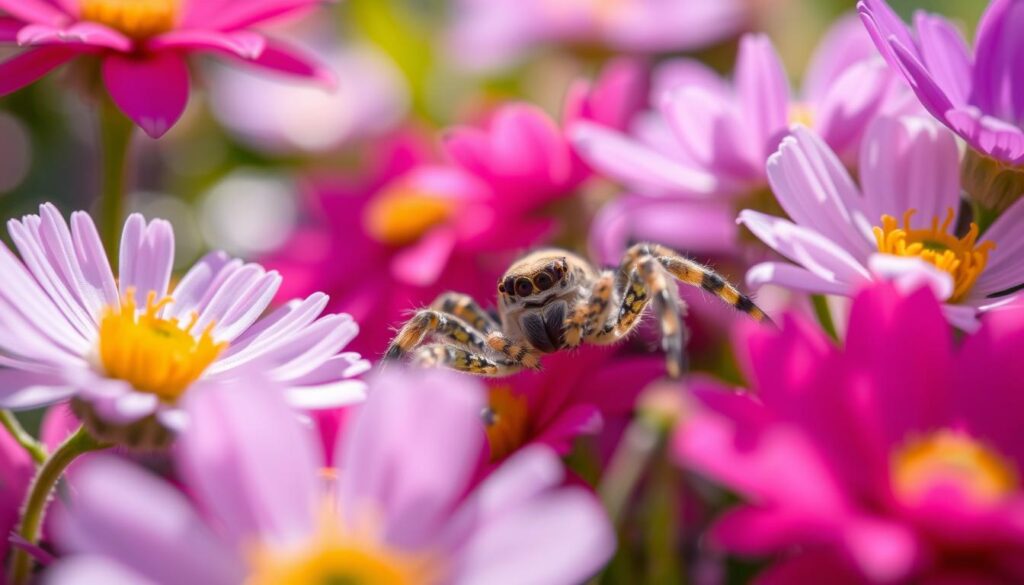
Conservation Efforts and Threats
Crab spiders are fascinating with their unique ways and hunting skills. But, they face many threats that risk their numbers. The crab spider family (Thomisidae) has over 2,000 species worldwide. This shows the amazing variety in this spider group. Yet, habitat loss, climate change, and pesticides are big dangers to these spiders.
Habitat Loss and Climate Change
When natural places are lost or changed, it harms the balance of nature. This can lead to fewer crab spiders. Climate change makes things worse by changing weather and temperatures. It messes up the relationships between spiders, their food, and the plants they hide in.
Preserving Biodiversity and Natural Habitats
It’s key to save habitats and grow food in a way that’s good for the environment. By planting native plants in our gardens, we help these spiders and other good bugs. Protecting natural habitats and keeping nature in balance helps crab spiders thrive. This is good for them and for the ecosystems they live in.
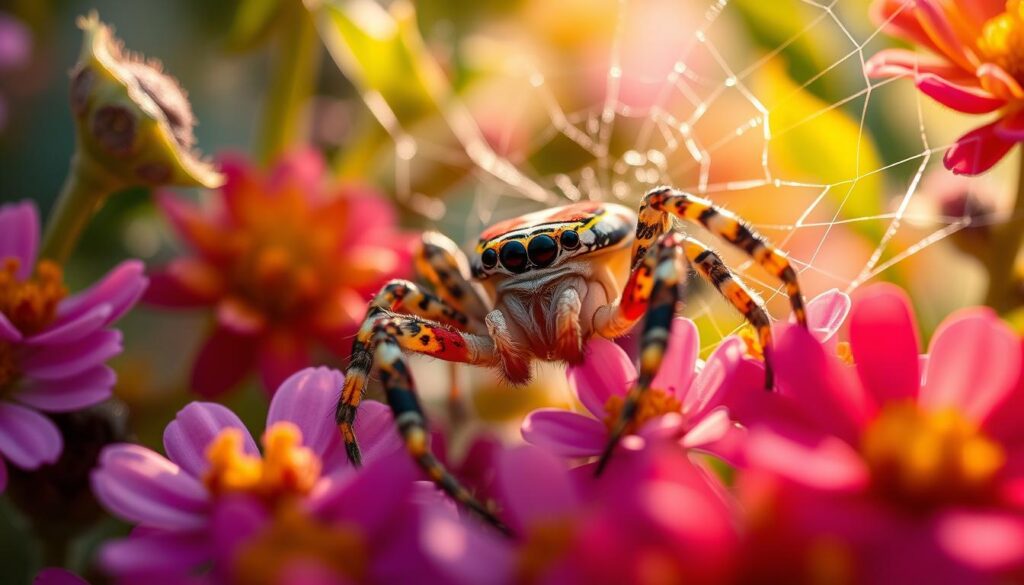
Appreciating Nature’s Tiny Ambush Hunters
Exploring the world of crab spiders reveals their worth. Their unique hunting ways, amazing camouflage, and key ecological roles show they’re vital. They are a big part of the nature we want to keep safe.
Crab spiders come from the Thomisidae family, with over 2,000 species. They have flat bodies, long legs, bright colors, and patterns. These features help them hide and strike quickly when they find prey.
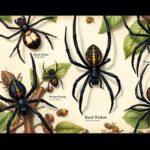 Types of Black Widow Spiders Near You
Types of Black Widow Spiders Near You
Learning about crab spiders helps us see the value of our ecosystems. They help control insect numbers, keeping their habitats healthy. Their presence shows us the need to protect our environment. It reminds us of the importance of conservation.

